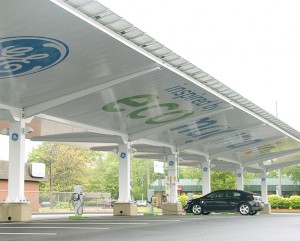
As plug−in electric vehicles begin hitting the road, GE’s Electric Vehicle (EV) Charging Station stands ready to serve the millions of cars that will be plugging in instead of fueling up. With the EV Charging Station, GE builds on a century of innovation in designing and manufacturing electrical distribution systems.
GE’s EV Charging Station is ideal for various locations. Developers of commercial properties may achieve higher LEED status by setting aside parking for low−emission vehicles. The station also works in residential settings, where its user−friendly design makes it an excellent choice for consumers wanting a durable, safe, at−home solution.
GE’s Solar Carport solution combines several GE technologies-including GE EverGoldTM combiner boxes and disconnects, GE’s Durastation and Wattstation electric vehicle (EV) charging stations, and AC distribution equipment-to integrate EV and solar into a grid-tie photovoltaic system used for charging EV fleets. GE’s Solar Carport solution, when combined with solar panels, inverters, and a carport structure provides EV fleet owners a turn-key charging solution.
Environmental Benefits
GE’s Solar Carport solution allows fleet owners to reduce electricity consumption by decreasing the amount of electricity pulled from the grid for electric vehicle (EV) charging and, depending on system design, other electrical loads. A solar carport customer with a fleet of six EVs could reduce electricity usage up to 20,000 kWh per year, avoiding 12 metric tons of associated CO2 emissions that would have otherwise been generated from charging on the U.S. grid.
Operating Benefits
GE’s Solar Carport solution allows fleet owners to reduce electricity consumption by decreasing the amount of electricity pulled from the grid for EV charging and, depending on system design, other electrical loads. A solar carport customer with a fleet of six EVs could reduce electricity usage up to 20,000 kWh per year, saving approximately $2,000 annually in energy costs compared to charging on the U.S. grid, assuming an electricity price of $0.10/kWh.